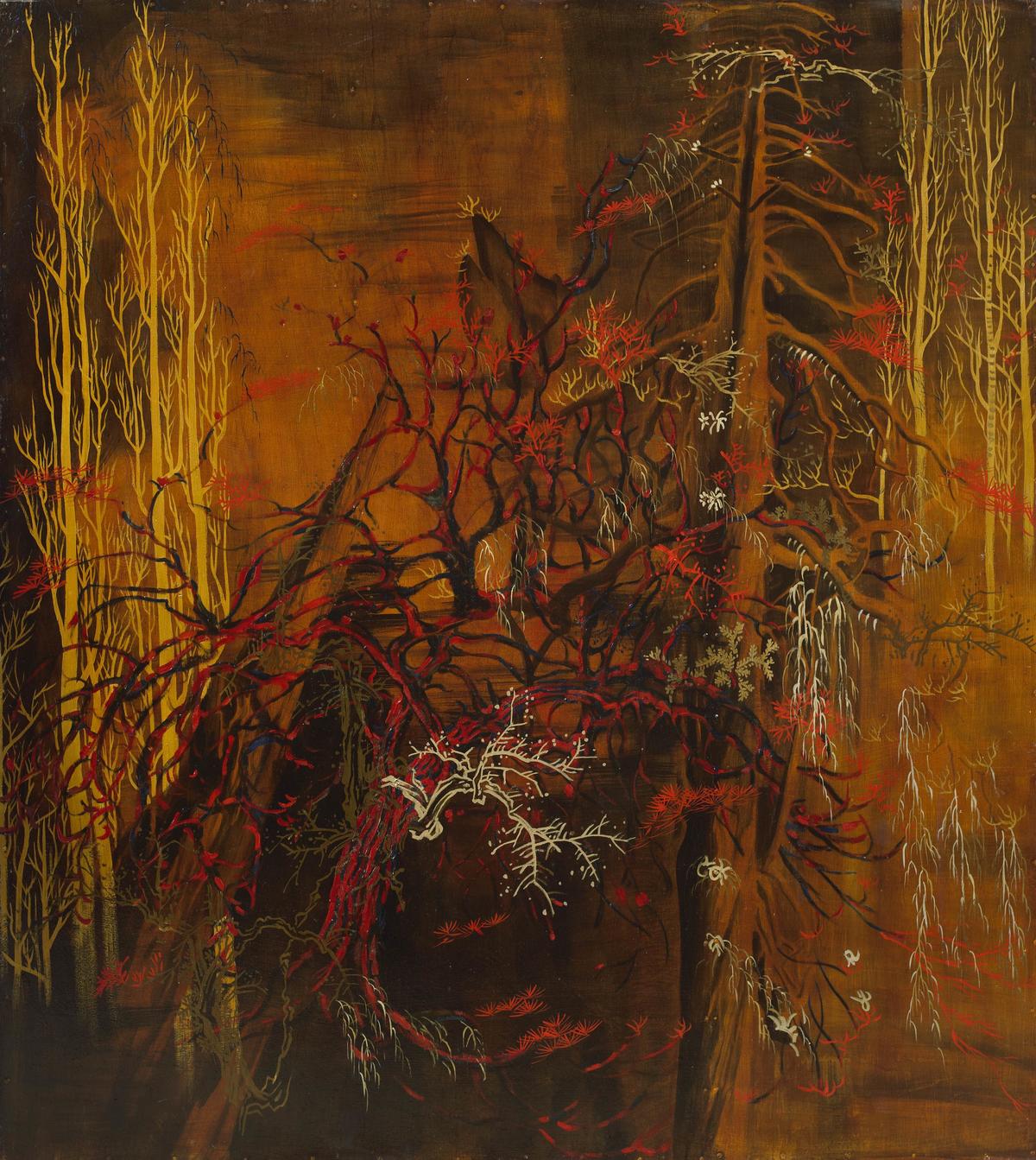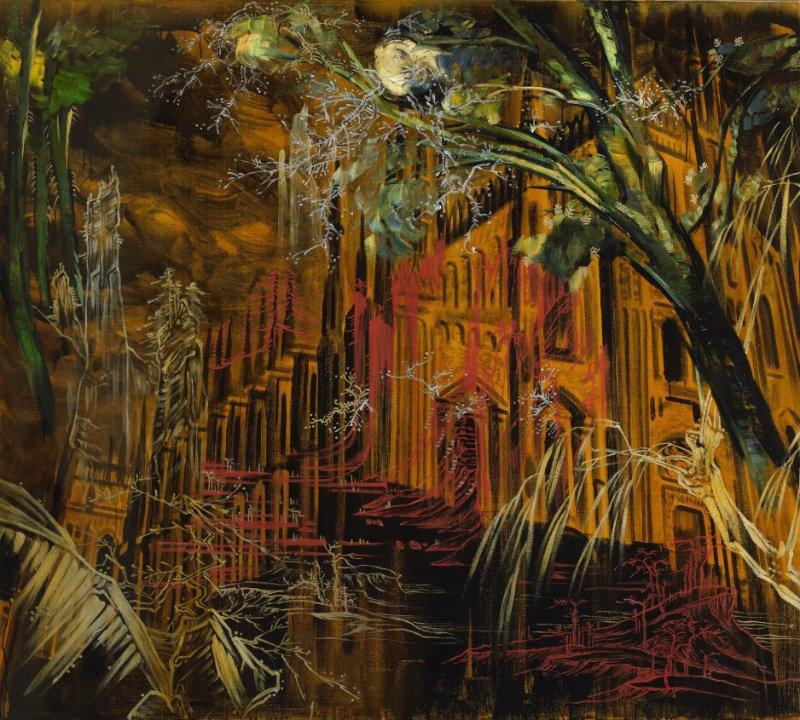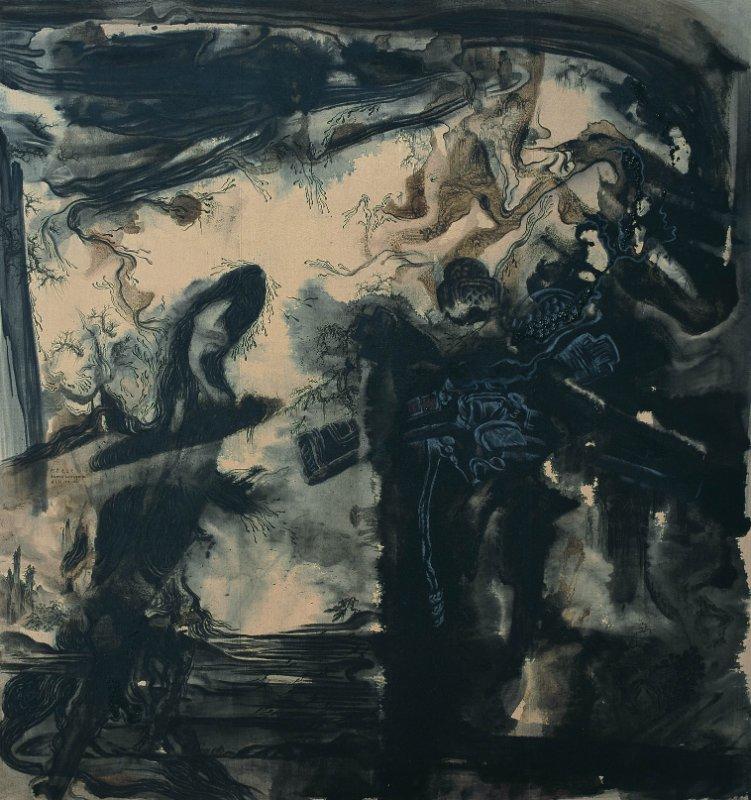志穎和他的畫
呂品田(中國藝術研究院研究員,博士生導師)
志穎和他的畫
呂品田(中國藝術研究院研究員,博士生導師)

胡志穎 天文之二,1995,板上綜合媒介,180×200cm HU ZHIYING Astronomy Ⅱ, 1995 Mixed media on plank, 180×200 cm
志穎的繪畫是獨特而穎異的,在國內畫壇堪稱獨樹一幟。以我之見,其繪畫上的種種獨特性或新穎性,並不突兀,自有合乎其個人經歷和情理的由來。
中國傳統藝術的童子功(圖01)和刻骨銘心的文化眷戀,時代際遇和藝術探索為之打開的西方藝術視界,讓他或許不像許多為風潮所動的前衛藝術家那樣,深切地感受到一種影響其內心世界和藝術觀的文化張力。構成這種張力的兩個文化感受源,對他來說都是那般的博大雄厚。他無法在自己的內心處調解所感受到的彼此的差異性衝突,似乎也難以把自己的靈魂單純地寄託於任何一方。天性沉靜、不愛言語的志穎,因而有了由思想認識所引發的精神張力——一種有如箭在弦上、張而未發般“緊張”的心理情結。這種心理因素醞釀著滿腔的不斷升騰的熱情,孕育著終究需要釋懷的強烈表現慾和繽紛形式感。 “我無法抑制地需要某些特別的方式表達自己”——志穎深切地感覺到了已然蘊蓄的內在張力,他需要切合內省經驗地盡情表達。呈現在我們眼前的、他的那些獨特而穎異的畫作,當是如其所願的一種“既溶解理智的堅冰,又平息激情的噴薄;而以自然宿命和人為秩序統一內心深處無以名狀的靈魂語言,獲得既穩定永恆,又給幻想玄思以極大空間的表達方式。”

(Fig. 01) Copying the “87 Immortals” 1978, ink on Chinese paper, 23×43 cm (圖01) 節臨《八十七神仙卷》 1978,紙上水墨,23×43cm
畫作所透露的心理圖式,似乎讓少時的志穎在我的視界里遠去。而迎面過來的這一志穎,如其畫上那一個一個的形式元素難以按常規來解讀來連貫一樣,也有著不能簡單地加以揣摩的複雜內心世界。
我不認為志穎是以故作玄奧的策略來製造驚世駭俗的所謂“現代性”,或者後現代所謂的“震驚”美學效果,因為那個曾經的鬧市已經收場。志穎是敏感型的藝術家,他一定會敏銳地察覺時代的新的脈動。眼下現實中,最強勁的一種時代脈動,是“文化多樣性”訴求在“全球化”情勢中的逆勢上揚。面對我未必揣摩得清楚的今天的志穎,我更願意將他的藝術追求和價值實現置於這樣一個時代場域和這樣一種人文訴求來解讀,以至於將其畫上那些難以按常規來解讀來連貫的形式元素,理解為突破單一文明價值觀和單一文化認知圖式的新世界的拼圖。志穎的自述,或許可以支持我的這種難免主觀的解讀——對於自己的表達需要,他認為無法固定於某一種模式或風格而要訴諸相互衝突、迥然不同的狀態或方式,並強調:“只有兩種或多種強烈反差的情緒和思維活動所形成的廣闊巨大的空間方能滿足我的這一需要。我一直以來都傾心於我以為十分重要的'文化反差',因而我的作品常常出現東西方不同元素的交織,通過多種材料甚至綜合媒介來表達這一反差,最終的效果卻又皈依於單純。”以我的直觀感受,志穎的解構藝術作風和畫面處理,在視覺地呈現文化的“反差”方面,的確非常有力。
在為“反差”而灑落幅間的那許多圖形影像的碎片中,我惟恍惟惚地覺得少時的志穎不時迎面而來。那些依稀可辨的古典山水畫片段、帶筆墨意味的局部掃描、鄉土格調的色彩處理以及大漆硍硃之類的典型中國材料,似乎是文化記憶的一種緘默提示,讓我斷斷續續地感到某種曖昧的親切。每當這會,我總是試想:志穎在遣調它們的時候會是怎樣的一種心情。我對他的“嘿嘿一笑”印象太深,實在無法超拔,以至於總是想著能在某個“碎片”上追尋到自己的歷史經驗。這無疑是徒然的。如今,一切作為歷史經驗的“熟悉”,已在畫裡化作“無以名狀的靈魂語言”,緘默著任你追問任你揣度。
這便是“解構”的魅力。(图02)

(Fig. 02) HU ZHIYING EquationsⅡ, 1996, mixed media on canvas, 180×200cm (圖 02) 胡志穎 方程式之二,1996,布上綜合媒介,180×200cm
志穎的畫上,“文化多樣性”呈現為解構的繽紛的“文化影像”,它折射著藝術主體不以某種文化認同為歸宿的“自我的解構”。集合於畫面的一切,僅僅是“文化影像”的形式重組而非“文化認同”的意義建構。因此,他的繪畫藝術讓我們持續地感受到一種張力凸顯的緊張感,也讓我們持續地直面著一種畫家所傾心的“文化反差”。這種基於相互衝突、迥然不同狀態或方式的絕對化的“緊張”和“反差”,也許就是畫家所希望的“皈依於單純”的最終效果。在交織不同元素的畫面上,你不必徒勞追問和揣度最終的東西,“單純”就是單純,一切如你所見。要知道,表現“解構的自我”,結果只會是“涵義復雜而不確定”;而對於“自我的解構”的表現,任何的心理反應或閱讀理解都是確當的終極解讀。(圖03)
(資料來源:鮑 棟編《在幻想鎖鏈的彼岸——胡志穎繪畫作品1989-2009》,中國環球文化出版社,香港)
Zhiying and His Paintings
Lv Pintian (researcher, supervisor of doctoral candidates at Chinese National Academy of Arts)
The paintings of Zhiying are distinctive and original, and can be said to constitute a unique school in the domestic painting circles. In my opinion, the distinctiveness and originality of his paintings, rather than ungrounded, is reasonable and conformable to his personal experience.
His solid grounding in traditional Chinese art (fig. 01), his deep affection for culture, and his contact with Western art made possible by the opportunity of the times and his art research, make him, perhaps unlike many avant-garde artists susceptible to the trends, feel deeply a kind of cultural tension which has an influence on his inner world and view of art. Both of the two sources of cultural sensation constituting this tension are so rich and profound for him that he cannot mediate the conflict between their mutual differences he feels at the bottom of his heart, and it seems hard for him to find spiritual sustenance in either single side. Zhiying, a quiet man of few words by nature, thus has a spiritual tension resulting from his ideological understanding – a “tense” psychological complex like an arrow on the bowstring waiting to be shot. This psychological factor leads to the brewing of enthusiasm which keeps rising in his heart, a strong desire of expression to be released earlier or later, and a profuse sense of form. “I need uncontrollably some special modes to express myself.” – Zhiying has deeply felt the already latent inner tension, and he has the need to express himself to his heart’s content in a manner fit in with his introspective experience. His distinctive and original paintings before our eyes are exactly what he desires them to be: “both to melt the hard ice of reason and subside the outburst of passion; to unify the language of the soul beyond description in the depth of human mind with natural fatalism and man-made order and obtain a stable and eternal mode of expression that will provide enormous space for illusion and fantasy.”
The psychological schema revealed in his paintings seems to make me feel that the young Zhiying is fading away in my field of vision, while the present Zhiying before us has a complicated inner world we cannot figure out in a simple way, just as the formal elements in his paintings cannot be read or made coherent in a conventional way.
I don’t think that Zhiying is trying to create an astounding “modernity” or a so called “shocking” aesthetic effect of postmodernism by using the tactic of deliberately being abstruse, for the once boisterous scene is already over. As a sensitive artist, Zhiying must be able to perceive the new pulse of the times acutely. The most powerful pulse of the times at present is the rise of the appeal of “cultural diversity” against the general tendency of “globalization”. As for the Zhiying of today whom perhaps I cannot figure out clearly, I prefer to read his pursuit of art and value realization in terms of such times context and such humanistic appeal that I understand the formal elements in his painting which one cannot understand or make coherent easily in a conventional way as a picture collage of a new world in which the unitary values of civilization and unitary schema of cultural cognition are broken. Perhaps his self-account can serve as a support of my unavoidably subjective reading. He thinks that, due to his won need of expression, he cannot limit himself to a certain mode or style, but should resort to conflicting and utterly different states or ways, and says emphatically, “Only the vast and enormous space formed by two or more kinds of sharply contrastive moods and thinking activities can satisfy this need of mine. I have been engrossed all along in the ‘cultural contrast’ which I think very important, and therefore interweavement of different elements of the East and the West often appears in my works. I try to express this contrast through various materials and even mixed media but the final effect remains simple.” I feel intuitively that Zhiying’s artistic style of deconstruction and treatment of his pictures are indeed effective in presenting the “cultural contrast” visually.
Among the fragments of images scattering in his paintings for the sake of expressing the “contrast”, I feel that the young Zhiying seems to come up to me at times. The vaguely discernible fragments of classical landscape paintings, the partial scanning with brush stroke effects, the treatment of color with local style, and typical Chinese materials such as Chinese lacquer and vermilion, seem to be a silent hint of cultural memory, making me feel a surge of warm feeling from time to time. At such moments, I always wonder what mental state he was in when he maneuvered them. His “slight laughter” has impressed me so deeply that I always attempt to find my own historical experiences in one of such “fragments”. This is no doubt in vain. Now, all the “familiarity”, as historical experience, has been reduced to “an indescribable language of the soul” in his paintings keeping silent for you to inquire into or conjecture about.
This is the charm of “deconstruction”. (Fig. 02)
The embodiment of “cultural diversity” in the form of a profusion of deconstructive “cultural images” in the paintings by Zhiying reflects the “self-deconstruction” of the artist not taking a certain cultural identity as his destination. All things included in his painting are merely a formal regrouping of “cultural images” rather than a meaning construction of “cultural identity”. Therefore, in his paintings we feel continuously an obvious tension, and face continuously the “cultural contrast” the artist has made great efforts to express. This absolutised “tension” and “contrast” based upon conflicting and utterly different states or modes may be the final effect of “remaining simple” the painter hopes to achieve. In the paintings in which different elements are interwoven together, you need not make a futile effort to inquire into or conjecture about something final. “Simple” is simple, and everything is as you see it. You should know that, the expression of “deconstructed self” can only result in the “complexity and uncertainty of meaning”; while any psychological reaction to or understanding of the expression of “self-deconstruction” is proper ultimate reading. (Fig. 03)
 (Fig. 03) HU ZHIYING Buddhist Scriptures Ⅶ, 1999-2003, acrylic, ink, charcoal, oil crayon, plant pigment on silk on plank, 195×183 cm (圖03)胡志穎 內典錄之七,1999-2003,絹上丙烯,墨,木炭,油畫棒,植物顏料,195×183cm
(Fig. 03) HU ZHIYING Buddhist Scriptures Ⅶ, 1999-2003, acrylic, ink, charcoal, oil crayon, plant pigment on silk on plank, 195×183 cm (圖03)胡志穎 內典錄之七,1999-2003,絹上丙烯,墨,木炭,油畫棒,植物顏料,195×183cm
(Bao Dong, Beyond the Chains of Illusion – Hu Zhiying’s Painting 1989 - 2009, China Global Culture Publishing House, Hong Kong)